
ATC’s essential guide to ski racing

The Parents’ Guide
All about ski racing – a guide for parents
“My son will never ski in the World Cup. Why, then, do I spend so much time and money on ski camps? This type of sport is a way for him to develop both physically and mentally during the important years. He has become totally dedicated to something. He has developed pride, self confidence, mental awareness, lasting friendships, punctuality and pride in his appearance. Short of the military, he has become regimented in his actions both at home, school and on the mountain. He doesn’t like to lose, but has become more gracious about it. He certainly doesn’t have time to be bored. He has learned to take criticism and accept praise graciously. All of these qualities take some people a life to attain My son is 12 years old. ”
Within the ASTATC coaching team we have Olympians, multiple national champions., Some of our coaches are surgeons, engineers, school teachers and, of course, some of us are parents too. Here is their collective advice to parents of young ski racers.
Choose your age group
Foundation
Development
Athlete
The Long Term
Athlete Development plan
Stages of development
Maturity
Balance
Sport specialisation
No short cuts
Financial
While many sports in the UK have adapted to new methods and philosophies of coaching, snowsports are not among them. Set against a backdrop of parents and athletes desperately in need of a cohesive plan to understand and follow, up the athletic ladder, we continually struggle to provide clarity and clear direction. Awareness, education and long-term planning help club coaches coach, club committees commit to a pathway, and club athletes feel supported. We can all strive to reach our goals in the safest and most productive way possible.
The Long Term Athlete Development (LTAD) plan aims to provide a safety net to protect, direct and empower athletes, parents and coaches alike, while offering them sound knowledge and understanding of the world of a developing ski racer. Athletes with a sound physical, psychological and technical background development not only progress further, they also have a healthy passion for the sport.

7 stages of athlete development
Like the building blocks on a Jenga tower, having a strong foundation means that athletes can be stronger, faster and reach higher levels of performance. In short, smart long term athlete planning enables athletes to reach their maximum potential.
Stage 1
Active Start
Age 0-5
Physical activity habits and enjoyment
Agility, movement and quickness
Stage 2
FUNdamentals
Age 6-9
Varied movement skills (multi-sport)
Follow and copy with variety
Stage 3
Train to train
Age 10-12
Consolidate specific ski-racing skills
Routines and community
Stage 4
Train to train
Age 13-15
Consolidate specific ski-racing skills
Practice and understanding
Stage 5
Train to compete
Age 16-18
Fine-tuning skills (filling in the gaps)
Gain a qualification
Stage 6
Train to win
Age 18+
Maximise ski-racing skill
Gain qualifications and experience
Stage 7
Active for life
Age 25+
Learn new skills and carry skills forward
Physical
training
and maturity
It is worth noting that girls mature earlier than boys. Peak height velocity (PHV) measures the maximum rate of growth in height in a single growth spurt. This tells us the development age of athletes. In most cases the PHV (growth spurt) for girls is a year earlier than for boys (appendix 4).
The strength-training window for boys begins 12 to 18 months after PHV. There are two windows of opportunity for strength training for girls. Window one is immediately after PHV. Window two begins with the onset of menarche (first occurrence of mensuration).
Special emphasis is also required for flexibility training due to the sudden growth of bones, tendons, ligaments and muscles. Coaches / parents can monitor PHV to adapt training. In snow sports this is especially relevant in strength and conditioning. Click here to find out more about PHV.
Providing
balance
The Performance Bubble - Ian Linklater’s concept of growing areas of performance (bubbles) in balance with each other. When using this method one can easily see which bubbles need to grow
Specialising
in sport
Like most sports, Alpine and Freestyle skiing are late specialisation sports. This means that they can be taken up, or started later in a young athlete’s sporting life, perhaps from 8 to 12 years old or even later in the UK. Early specialisation sports like swimming and gymnastics need involvement and specific focus at a very young age to succeed in the long term.
Although Alpine and Freestyle are categorised as late specialisation, they are also considered to be ‘early engagement kinaesthetic sports’. Athletes need to engage with snow early to develop a high degree of feel for the snow they are moving on.
Istvan Balyi (World expert in athlete development) - In the UK we have shown that it is possible to start later than this.
The ATC Alpine Matrix offers a rough idea of training and racing time required for all ages of young competitive ski racers.
No short cuts
There are precious few short cuts in developing athletes. Short cuts result in injury, burnout, and a lack of enjoyment and fulfilment in the sport. An example of this is with boys and girls who mature earlier than their year group. The early strength advantage makes them fast, but often at the expense of important fundamental skills. A few years on this often leads to a performance ceiling where progress becomes very difficult, and risk of injury high.
It takes a considerable length of time to be world class. It is very important that, when coaching children, we progressively build a wide array of multi-skills before and alongside trying to build sport-specific skills:
Multi-skills are the foundation for any sport-specific techniques and skills
Children with solid foundations in the Fundamentals of Movement pick up sport-specific skills better and do so more quickly.
In modern sport, players and athletes need to be able to do a great number of things to succeed. The days of one-trick ponies have long gone in professional sport. Hence, the bigger the children’s skills bank, the better for them.
Winter Sports Foundation
The Winter Sports Foundation is a Gift Aid charity, aimed at making your money go further.
The WSF charity offer a personal sports fund service. Many ATC parents past and present have used it’s services. In essence, if you spend £5000, you can save £1000 through Gift Aid. We recommend all ski racing families have a look at this service.
You can contact Elliott Emery by email at enquiries@wintersportsfoiundation.co.uk or call him on 077349 72851. Just explain that you are training with ATC and you would like to discuss how they can help you.
I believe over the years there has been some scepticism over these types of funds and charities. Elliott and his team at WSF have recently had a full audit between March 2020 and Sept 2020 and been given the go-ahead to continue with the service they offer.
Best of all is that the WSF give back to ski racing in the form of grants and bursaries to organisations like ATC. For more information on the ATC bursary programme click here. You can visit the Winter Sports Foundation website for more information or to open a sports fund for your child here.








